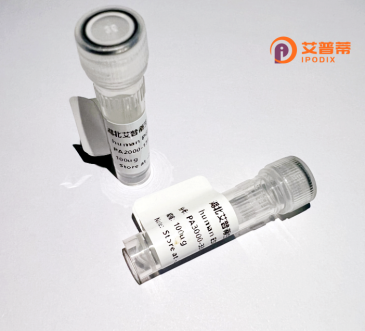
| 纯度 | >90%SDS-PAGE. |
| 种属 | Human |
| 靶点 | CCT5 |
| Uniprot No | P48643 |
| 内毒素 | < 0.01EU/μg |
| 表达宿主 | E.coli |
| 表达区间 | 1-541aa |
| 氨基酸序列 | MASMGTLAFDEYGRPFLIIKDQDRKSRLMGLEALKSHIMAAKAVANTMRTSLGPNGLDKMMVDKDGDVTVTNDGATILSMMDVDHQIAKLMVELSKSQDDEIGDGTTGVVVLAGALLEEAEQLLDRGIHPIRIADGYEQAARVAIEHLDKISDSVLVDIKDTEPLIQTAKTTLGSKVVNSCHRQMAEIAVNAVLTVADMERRDVDFELIKVEGKVGGRLEDTKLIKGVIVDKDFSHPQMPKKVEDAKIAILTCPFEPPKPKTKHKLDVTSVEDYKALQKYEKEKFEEMIQQIKETGANLAICQWGFDDEANHLLLQNNLPAVRWVGGPEIELIAIATGGRIVPRFSELTAEKLGFAGLVQEISFGTTKDKMLVIEQCKNSRAVTIFIRGGNKMIIEEAKRSLHDALCVIRNLIRDNRVVYGGGAAEISCALAVSQEADKCPTLEQYAMRAFADALEVIPMALSENSGMNPIQTMTEVRARQVKEMNPALGIDCLHKGTNDMKQQHVIETLIGKKQQISLATQMVRMILKIDDIRKPGESEE |
| 分子量 | 85.25 kDa |
| 蛋白标签 | GST-tag at N-terminal |
| 缓冲液 | 0 |
| 稳定性 & 储存条件 | Lyophilized protein should be stored at ≤ -20°C, stable for one year after receipt. Reconstituted protein solution can be stored at 2-8°C for 2-7 days. Aliquots of reconstituted samples are stable at ≤ -20°C for 3 months. |
| 复溶 | Always centrifuge tubes before opening.Do not mix by vortex or pipetting. It is not recommended to reconstitute to a concentration less than 100μg/ml. Dissolve the lyophilized protein in distilled water. Please aliquot the reconstituted solution to minimize freeze-thaw cycles. |
以下是关于重组人CCT5蛋白的3篇典型文献名称、作者及摘要概述(基于近年研究整理):
1. **文献名称**:*Structural insights into the CCT5 subunit of human chaperonin TRiC/CCT*
**作者**:Leitner A. et al.
**摘要**:通过冷冻电镜技术解析CCT5亚基的三维结构,阐明其在TRiC复合体中的构象变化机制,揭示其与肌动蛋白折叠的特异性结合位点。
2. **文献名称**:*CCT5 mutation induces proteotoxic stress and accelerates neurodegeneration in a Drosophila model*
**作者**:Zhang Y. et al.
**摘要**:研究CCT5基因突变导致的蛋白错误折叠,通过果蝇模型证明该突变通过破坏TRiC复合体功能,引发神经细胞凋亡,与遗传性感觉神经病变相关。
3. **文献名称**:*Recombinant CCT5 expression system enables ATPase activity analysis in vitro*
**作者**:Kim D.W. et al.
**摘要**:开发大肠杆菌重组表达系统生产人源CCT5蛋白,体外验证其ATP酶活性及底物结合能力,为研究TRiC复合体的分子机制提供纯化工具。
以上文献分别涵盖结构生物学、疾病机制和重组蛋白功能分析的研究方向,具体内容可通过PubMed或Sci-Hub等平台检索标题获取全文。
**Recombinant Human T-Complex Protein 1 Subunit Epsilon (CCT5)** is a critical component of the chaperonin-containing TCP-1 (CCT) complex, also known as TRiC. This multisubunit molecular chaperone assists in the folding of nascent polypeptides, particularly cytoskeletal proteins like actin and tubulin, ensuring proper conformational maturation. CCT5. encoded by the *CCT5* gene, forms one of eight distinct subunits arranged in double-ring structures, enabling ATP-dependent substrate binding and release. Its function extends beyond protein folding to involvement in cellular processes such as cell cycle regulation, chromatin assembly, and stress response.
CCT5 exhibits conserved structural motifs, including ATP-binding domains critical for its chaperone activity. Dysregulation or mutations in CCT5 are linked to neuropathies, including hereditary sensory and autonomic neuropathy type II (HSAN II), and distal spinal muscular atrophy, highlighting its importance in neuronal health. Studies also suggest roles in cancer progression, where altered expression may influence tumor cell proliferation or survival.
As a recombinant protein, CCT5 is utilized in vitro to study chaperone mechanisms, protein-protein interactions, and disease models, offering therapeutic research potential. Its conserved structure across eukaryotes underscores its evolutionary significance in maintaining proteostasis.
×